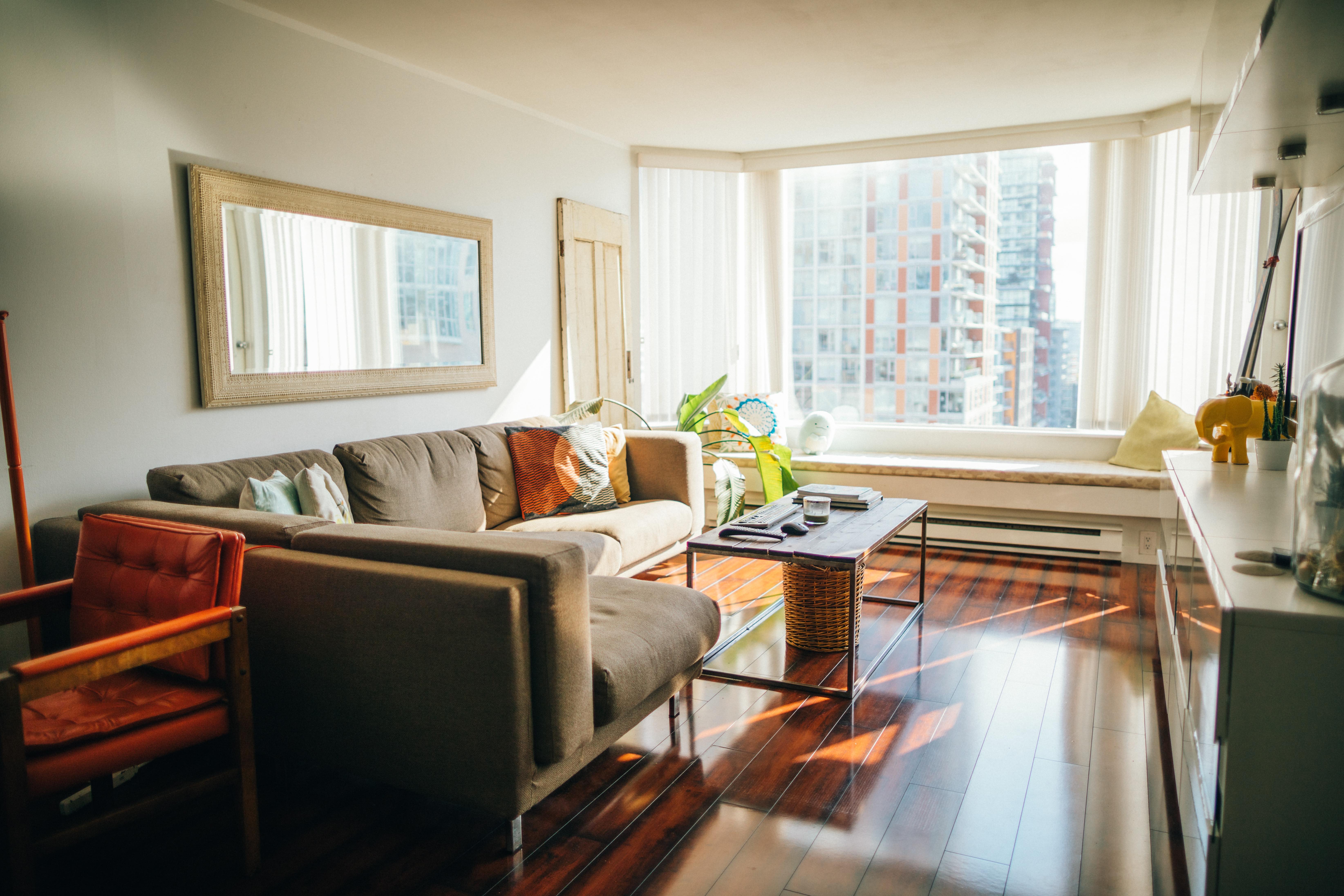Jump Ahead To:
Congratulations!
You’ve decided to move into your first apartment. A step you’ll remember as one that moved you closer to more options and independence in your adult life.
Welcome to the rentors’ side.
This transition is challenging on a number of levels, but the following information will take any of the unknown and logistical stressors off your plate.
You need to be focusing on furnishing your new apartment, cherishing the adventure of this new transition, and exploring your new town or city. Not stressing out over losing your dream apartment because you didn’t have right documents prepared. Or wasting money on another circular wooden cheese board that, you may think will add chic to your new apartment, but will actually just add clutter.
So take a look at the guide and checklist below for all the details on how to find, land, and fill your first apartment.
Everything you need to know: First Apartment Guide
THE PREP
This first step consists of mainly financial preparation.
Moving into your own apartment usually requires more responsibility and bills than you may be used to in your current living situation.

Apartment Buying Guide
So here are three ways to make sure you are fully prepared to claim the apartment you want.
- Secure a steady income. This step isn’t just for your security and sanity. Many apartments require you to prove you can afford their rental charges. Usually, you can bring the last several months of pay stubs, and that’ll do the trick. Check with the landlord and make sure they don’t want other documentation (like a tax return). If you’re moving to a new city and starting a new job or haven’t found one yet, you may be able to co-sign with a parent, guardian, or partner. In this way, the landowner has security that you (or your co-signer if you don’t) will cover your monthly rent.
- Create a budget. Before you begin perusing apartments, take a very good look at your budget. If you haven’t made a budget or updated it recently, sites like Mint can be really helpful. Include budgets for any bills, payments, debt, savings, and spending money you’d like for clothes, travel, restaurants, bars, etc. Now figure out how much money you have remaining to spend on rent and utilities. Feel free to adjust your budget to make room for higher rent (if that’s your priority).
- Save for the fees. Most apartments have you pay a chunk upfront when you sign a new lease. These fees may include an application fee, a security deposit (usually the same amount of one month’s rent), administration fee, and at times first and last month’s rent. All in all, if you’re wanting to rent an apartment for $800 / month, you may need to save up close to $3000 depending on what your new landlord requires.
Additionally, moving your stuff costs money too. Especially if you rent a moving truck, hire professional movers, or plan to take a day off work to get the job done.
Sounds like too much? Not if you’re prepared!
Saving up in advance, though not always absolutely crucial, will open up a lot more options for you as you search around for your new dream home. If saving up this much cash is out of the question, don’t sweat it. In the next section we will explain how to find an apartment that fits your needs, wants, and budget.
THE SEARCH
Let’s dive right back into finances.
Other than location, finances will be the most defining parameter while you’re looking for a place to live. As explained above, spending time to save and maintaining a steady income will allow you to look at more options.

But maybe you don’t have or don’t want to spend that much on rent. So here are seven options to seek out if you’re wanting to stick to a stricter budget:
- Start your search in advance. May-August is the busiest season for rentals, so if you want to find a good deal for an apartment iin the summer, it’s crucial to start looking a month or two in advance.
- Move in with one or two roommates and cut your rent by at least half. When deciding whether you want roommates, consider how particular you are about your living space. Honestly assess how clean, quiet, routined, private, etc. you want your home to be. Does the potential roommate want to rent as long as you do, or will you have to find another roommate in a year? Are they reliable? Do they pay their bills on time? Try to find a compatible roommate who won’t leave you high and dry four months into your lease.
- Scale back from central city and find cheaper rent. Oftentimes the most expensive apartments are the prettiest buildings in the most convenient locations downtown. Understandable. But if you’re willing to spend a few more minutes driving to the downtown shops, you may score a significant discount to your rent. Look for areas surrounding the downtown that haven’t gained popularity. You may even be able to spot up and coming areas that are cheaper!
- Pup or no pup? If you’re bringing along a furry friend, you’ll need to make sure the apartments you’re looking at allow pets. But also, pet fees vary. Some apartments require a one time pet fee, which can be a few hundred dollars, or a monthly pet fee (somewhere around $25-50/month, sometimes more depending on the city). So shop around and find the right fit for you and fur face.
- What is included? Some apartments charge a monthly rent, but will lump in some of your utilities in that fee! Which means, you may find one apartment with a rent fee of $650/month, and another apartment with a rent fee of $700/month, but the latter fee includes your water, sewer, and trash payments. So ask at each apartment whether any utilities are included in rent, and maybe save a few monthly dollars.
- Consider both large complexes and private rentals. Don’t limit your searches to the big guys. Those are usually easiest to find, but you can often find larger, better looking, and cheaper spaces for rent from private rentals. Check sites like Craigslist or sign up and post on neighborhood or town email lists to expand your searches of private rentals, (it’s useful for finding roommates, too). Just remember to confirm the posts’ legitimacy and safety before seeking these out.
- Work with whatcha got. Few Pinterest-users would walk into an ugly apartment and think, ‘there’s absolutely nothing to be done for this hopelessly hideous place.’ If you’ve got good essentials (neutral walls and hardwood floors), you are well set up for a very Pinterest-perfect home. Know that living in an less-than-LA apartment for a time, is normal and not something to be embarrassed about. I’ve been to a lot of cute apartments, but I’ve never met a young adult who didn’t have to work what they had.
Not that you’ve addressed the financial component and found the range of apartments that fit your needs and your budget, lets move a little closer with these three tips.
- Read the reviews. Once you’ve found a listing that interests you, hand the mic over to the people who’ve been there and done that. Previous renters often take the time to warn others if they’ve had a bad renting experience. Look over the reviews and see whether people have noted anything that makes you wary of or excited for the apartment.
- Visit the apartment in person. Once you’ve weeded out the apartments with significant bad reviews you’ll want to visit the remaining places in person. Visiting the apartment, as opposed to just looking at the pictures, will give you a realistic view of the style, aesthetics, and size of the apartment so you can accurately decide whether it matches what you want and need in a home. Also, there are a lot of apartment scams. So do NOT wire money to someone for an apartment without visiting it first and verifying its legitimacy.
- Ask questions. Asking direct questions will help to ensure you’re finding a good, reliable, and fitting place to live. So read over (maybe even print out) the following questions to ask when visiting a potential apartment.
- What is the turnover rate in the building?
- How long has the apartment been empty, and how long did the last tenant stay?
- How long is the lease?
- How much is the security deposit?How much is the rent and when is it due each month?
- What is the typical rent increase, and how often are rents increased?
- Under what conditions is breaking a lease acceptable, and can I sublease?
- Is there an on-site maintenance person, and how quickly do they respond to maintenance requests?
- Where’s the laundry and how much does it cost?
- Can I paint the apartment?
THE NEW HOME
Once you’ve narrowed down your search to a few, you’ll want to claim the space as your own before someone else snags it.

Here are seven steps to make a turn a just a potential apartment into your new home.
- Make a good first impression. While you are shopping for the right apartment, landlords are shopping for the right tenants. So be polite, considerate, and give the landlord reason to seek you out as his/her next renter.
- Be prepared to act fast. Especially in competitive markets, apartments can go in a day. So bring the following objects with you when looking at apartments so you can jump on one if its perfect.
- Your checkbook
- Contact info for references of previous landlords
- Proof of payment (pay stubs, a recent bank statement, and/or a recent tax return)
- Your credit score and your social security number for a credit check incase they want to verify
- Your photo ID
- Your vehicle information including a license plate number, make, and model number
3. Read through the lease. Thoroughly. Before you fill out your application read through the lease to make sure you’re on the same page as the landlord. Don’t sign it unless you agree and are willing to adhere to the lease, which will act as a contract between you both.
Once you’ve applied, been approved, and signed the lease, the apartment is yours!
Follow the remaining steps to insure a smooth transition into your new home.
4. Agree on the schedule. Determine with your landlord how early you can move in. They may allow you to move your things in a few days before your lease start date, but they may also charge you a fee.
5. Document any damage. Before you move in, inspect the apartment and take pictures of any damage done by a previous tenant. Bring it to the attention of the landlord or building manager immediately to avoid losing your security deposit when you move out.
6 . Make the move. Hire professional movers, ask friends for help, or do the deed yourself. If you’re stressed about this process, which is a big step in itself, look over this blog post, which will give you a step-by-step guide in how to find the help you need when moving.
Here are some popular moving destinations Bellhop works in:
- New York City Movers
- Dallas Movers
- Boston Movers
- Philadelphia Movers
- Pittsburgh Movers
- Los Angeles Movers
- San Francisco Movers
- Washington DC Movers
- Charlotte Movers
- Las Vegas Movers
- Find Movers Near You
7. Set up utilities and change your address. Call up your selected utility providers (water, power, internet, phone, etc.) and give them the needed information (like your billing info, new address, and date you’ll be moving in). Change your address on any profiles, memberships, and important documents (if you’re moving out of state, you’ll have to get an updated license and license plate). Finally, remember to alert friends, family, doctors, clubs, and communities of your move and new address.
Everything you need to have: First Apartment Essentials Checklist
Before you lose your remaining money on an unbridled shopping spree at Target, hit the pause button and consider what you need and what you love when deciding how to fill your new home.
Here is the most important tip we have:
Take. . . your. . . time.

Not only time to shop, but also time to reflect on what matters most to you. Make sure what you purchase serves a purpose, and buy with intention.
Consider the starting with the following list…
- Flashlight (or other emergency light)
- Essentials cleaning kit (Dr. Bronner’s Pure Castile Soap, white vinegar, sponge, vacuum, rags, mop and bucket, dusting spray, broom and dustpan, toilet bowl cleaner and scrub brush)
- Extra set of keys
- Two or three good knives
- Cutting board
- Can opener
- Plates / bowls
- Flatware
- Cookware: skillet, deep pot, oven baking dish, baking sheet
- Cooking utensils: wooden spoon, rubber scraper, spatula, ladle, serving spoon
- Towels (dish towels and bath towels)
- Ice cube tray
- Basic spices
- Paper towel holder
- Containers to store leftovers
- Fruit basket
- Trash cans (for the kitchen and bathrooms)
- Plunger
- Shower curtain
- Bath mat
- Toiletries
- First aid kit (Band-Aids, hydrogen peroxide, cotton balls, antibiotic cream, larger bandages, Ace bandage)
- Laundry essentials (laundry soap, fabric softener, a stain remover)
- Mattress, box spring, bed frame
- Sheets, pillows, pillow cases, blankets
- Dresser
- Hangers
- Nightstand
- Curtains
- Teapot / coffee maker
- Laundry hamper
- Couch
- Coffee table
- TV and stand / tableLighting for any rooms that don’t have enough built-in
- Dining table and chairs
- Fridge
- Microwave or toaster oven
- Blender
- Desk and chair
- Arm chairs (if you want more seating in the living room)
- Rugs
- Artwork and decor (remember to buy with intention)
- An umbrella
- Welcome mat
- Basic tool set
- Bookshelf
- Chest (for blankets and winter clothes)
- Key bowl / hooks (for purse and keys next to the door)
- Diffuser / candle / air purifier
We understand that moving into your own place is a huge step and a great accomplishment.
And we also know that it can be stressful. If you’re struggling with stress or if you worry about feeling at home in your new apartment, here’s a helpful guide that addresses the stress and sadness that many people experience during a big move.
But it also provides the tools needed to build a strong bond and home-sweet-home feeling wherever you live.
Additionally, choosing a reputable and affordable moving company is often something that relieves any move of added stress. It is important to understand how to compare moving company quotes so that you can hire the best movers for you!
And know that here at Bellhop, we work everyday to make sure that your move will be happy, smooth, and stress free.
- The 5 Best Neighborhoods in Saint Louis (Updated 2024) - March 15, 2024
- Is Moving to Pennsylvania Right for You? A 2024 Guide. - March 4, 2024
- The Best Neighborhoods in Cleveland (Updated 2024) - February 15, 2024



